BSBTWK503 Manage Meetings: Project on Meeting Management Skills
VerifiedAdded on 2023/06/10
|22
|5473
|339
Project
AI Summary
This document presents a student's submission for the BSBTWK503 Manage Meetings unit, including the project cover sheet and assessment task details. It outlines the student's declaration of originality, acknowledging the college's policies on plagiarism and academic misconduct. The assessment focuses on the student's ability to prepare for, conduct, and follow up on meetings, demonstrating skills in developing agendas, confirming meeting requirements, chairing meetings effectively, promoting participation, and managing meeting minutes. The document also includes information on assessment criteria, special needs support, skill recognition, and relevant academic policies, providing a comprehensive overview of the requirements and expectations for the Manage Meetings unit.
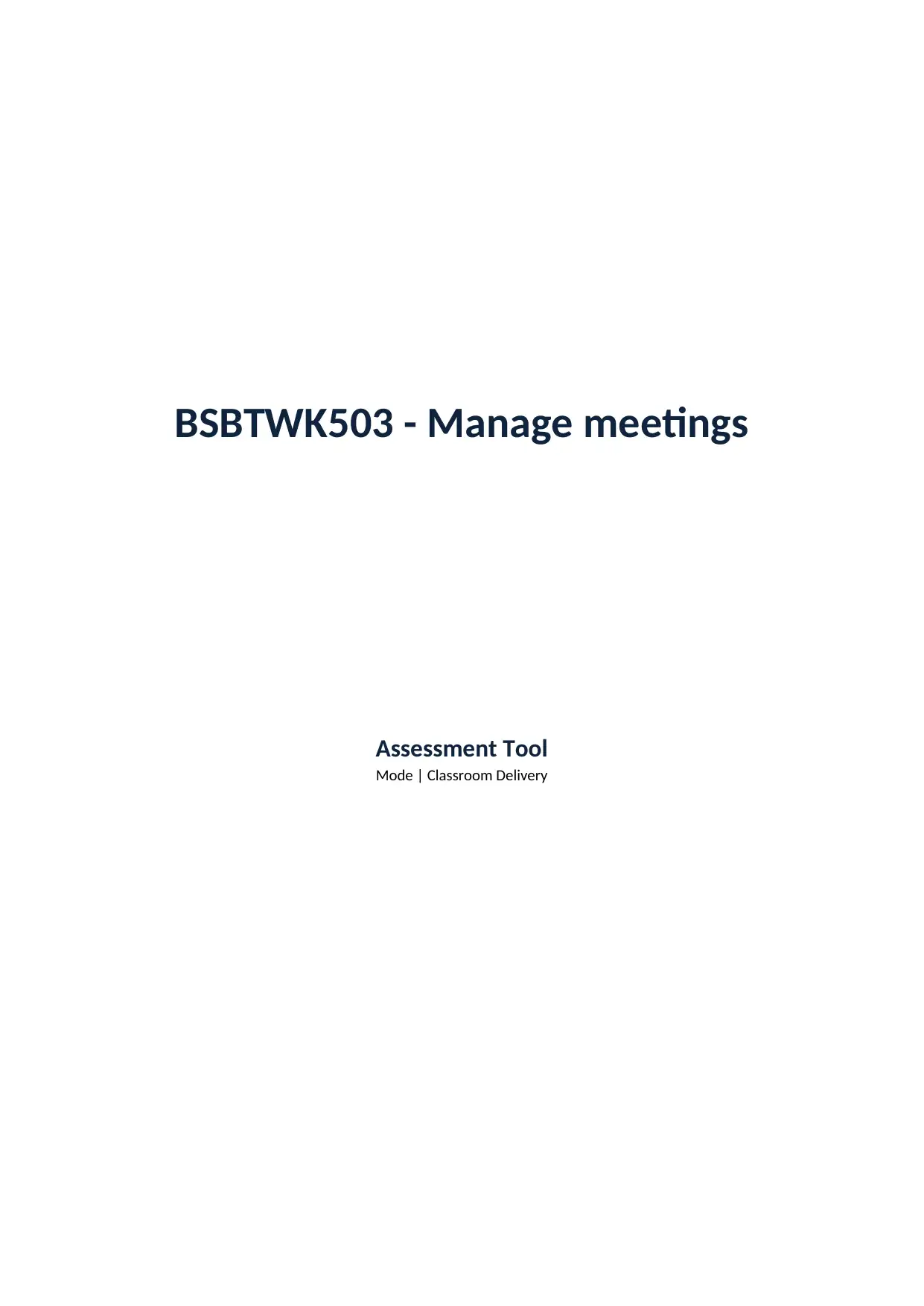
BSBTWK503 - Manage meetings
Assessment Tool
Mode | Classroom Delivery
Assessment Tool
Mode | Classroom Delivery
Paraphrase This Document
Need a fresh take? Get an instant paraphrase of this document with our AI Paraphraser
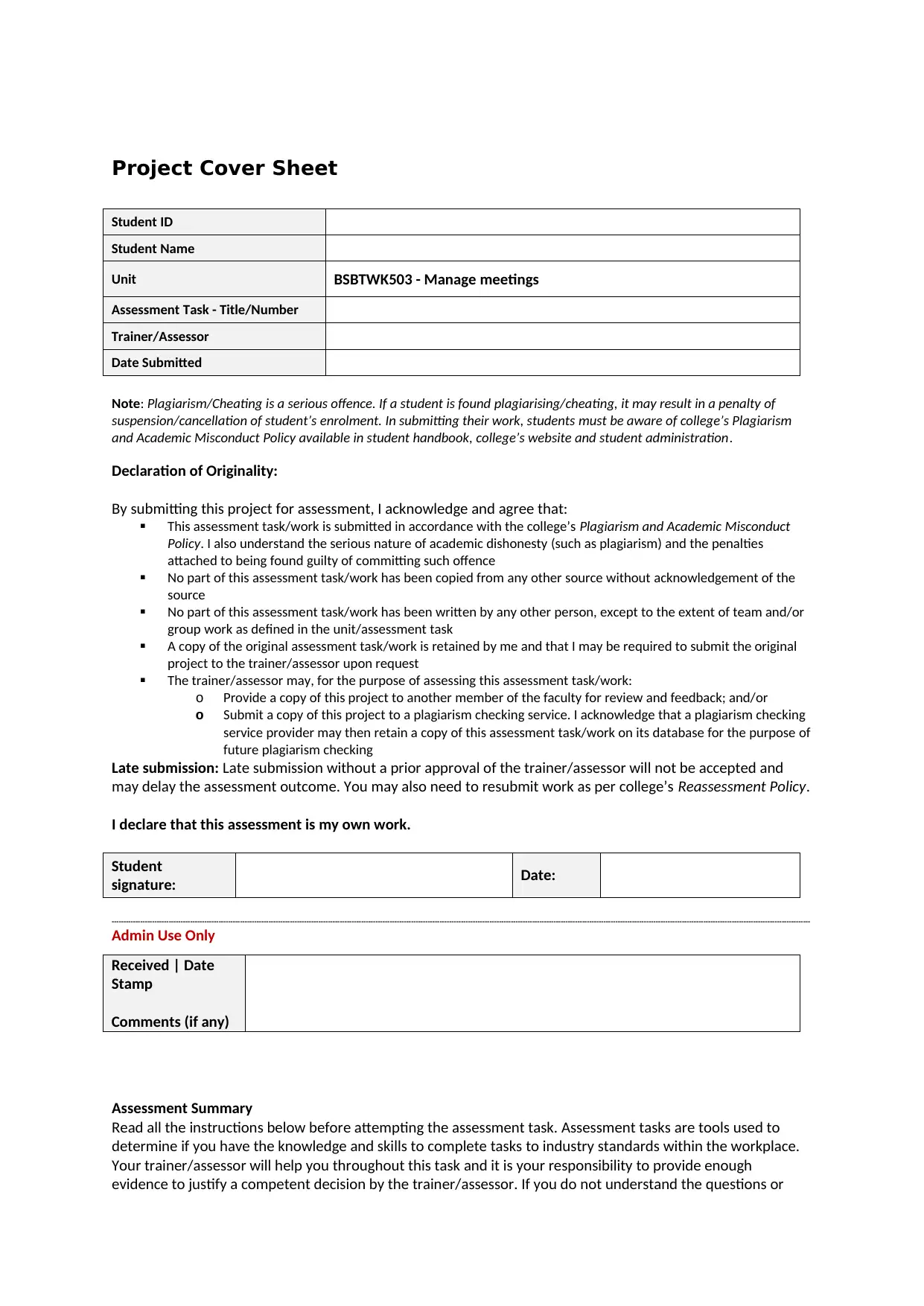
Project Cover Sheet
Student ID
Student Name
Unit BSBTWK503 - Manage meetings
Assessment Task - Title/Number
Trainer/Assessor
Date Submitted
Note: Plagiarism/Cheating is a serious offence. If a student is found plagiarising/cheating, it may result in a penalty of
suspension/cancellation of student’s enrolment. In submitting their work, students must be aware of college’s Plagiarism
and Academic Misconduct Policy available in student handbook, college’s website and student administration.
Declaration of Originality:
By submitting this project for assessment, I acknowledge and agree that:
This assessment task/work is submitted in accordance with the college’s Plagiarism and Academic Misconduct
Policy. I also understand the serious nature of academic dishonesty (such as plagiarism) and the penalties
attached to being found guilty of committing such offence
No part of this assessment task/work has been copied from any other source without acknowledgement of the
source
No part of this assessment task/work has been written by any other person, except to the extent of team and/or
group work as defined in the unit/assessment task
A copy of the original assessment task/work is retained by me and that I may be required to submit the original
project to the trainer/assessor upon request
The trainer/assessor may, for the purpose of assessing this assessment task/work:
o Provide a copy of this project to another member of the faculty for review and feedback; and/or
o Submit a copy of this project to a plagiarism checking service. I acknowledge that a plagiarism checking
service provider may then retain a copy of this assessment task/work on its database for the purpose of
future plagiarism checking
Late submission: Late submission without a prior approval of the trainer/assessor will not be accepted and
may delay the assessment outcome. You may also need to resubmit work as per college’s Reassessment Policy.
I declare that this assessment is my own work.
Student
signature: Date:
------------------------------------------------------------------------------------------------------------------------------------------------------------------------------------------------------------------------------------------------------------------------------------------------------
Admin Use Only
Received | Date
Stamp
Comments (if any)
Assessment Summary
Read all the instructions below before attempting the assessment task. Assessment tasks are tools used to
determine if you have the knowledge and skills to complete tasks to industry standards within the workplace.
Your trainer/assessor will help you throughout this task and it is your responsibility to provide enough
evidence to justify a competent decision by the trainer/assessor. If you do not understand the questions or
Student ID
Student Name
Unit BSBTWK503 - Manage meetings
Assessment Task - Title/Number
Trainer/Assessor
Date Submitted
Note: Plagiarism/Cheating is a serious offence. If a student is found plagiarising/cheating, it may result in a penalty of
suspension/cancellation of student’s enrolment. In submitting their work, students must be aware of college’s Plagiarism
and Academic Misconduct Policy available in student handbook, college’s website and student administration.
Declaration of Originality:
By submitting this project for assessment, I acknowledge and agree that:
This assessment task/work is submitted in accordance with the college’s Plagiarism and Academic Misconduct
Policy. I also understand the serious nature of academic dishonesty (such as plagiarism) and the penalties
attached to being found guilty of committing such offence
No part of this assessment task/work has been copied from any other source without acknowledgement of the
source
No part of this assessment task/work has been written by any other person, except to the extent of team and/or
group work as defined in the unit/assessment task
A copy of the original assessment task/work is retained by me and that I may be required to submit the original
project to the trainer/assessor upon request
The trainer/assessor may, for the purpose of assessing this assessment task/work:
o Provide a copy of this project to another member of the faculty for review and feedback; and/or
o Submit a copy of this project to a plagiarism checking service. I acknowledge that a plagiarism checking
service provider may then retain a copy of this assessment task/work on its database for the purpose of
future plagiarism checking
Late submission: Late submission without a prior approval of the trainer/assessor will not be accepted and
may delay the assessment outcome. You may also need to resubmit work as per college’s Reassessment Policy.
I declare that this assessment is my own work.
Student
signature: Date:
------------------------------------------------------------------------------------------------------------------------------------------------------------------------------------------------------------------------------------------------------------------------------------------------------
Admin Use Only
Received | Date
Stamp
Comments (if any)
Assessment Summary
Read all the instructions below before attempting the assessment task. Assessment tasks are tools used to
determine if you have the knowledge and skills to complete tasks to industry standards within the workplace.
Your trainer/assessor will help you throughout this task and it is your responsibility to provide enough
evidence to justify a competent decision by the trainer/assessor. If you do not understand the questions or
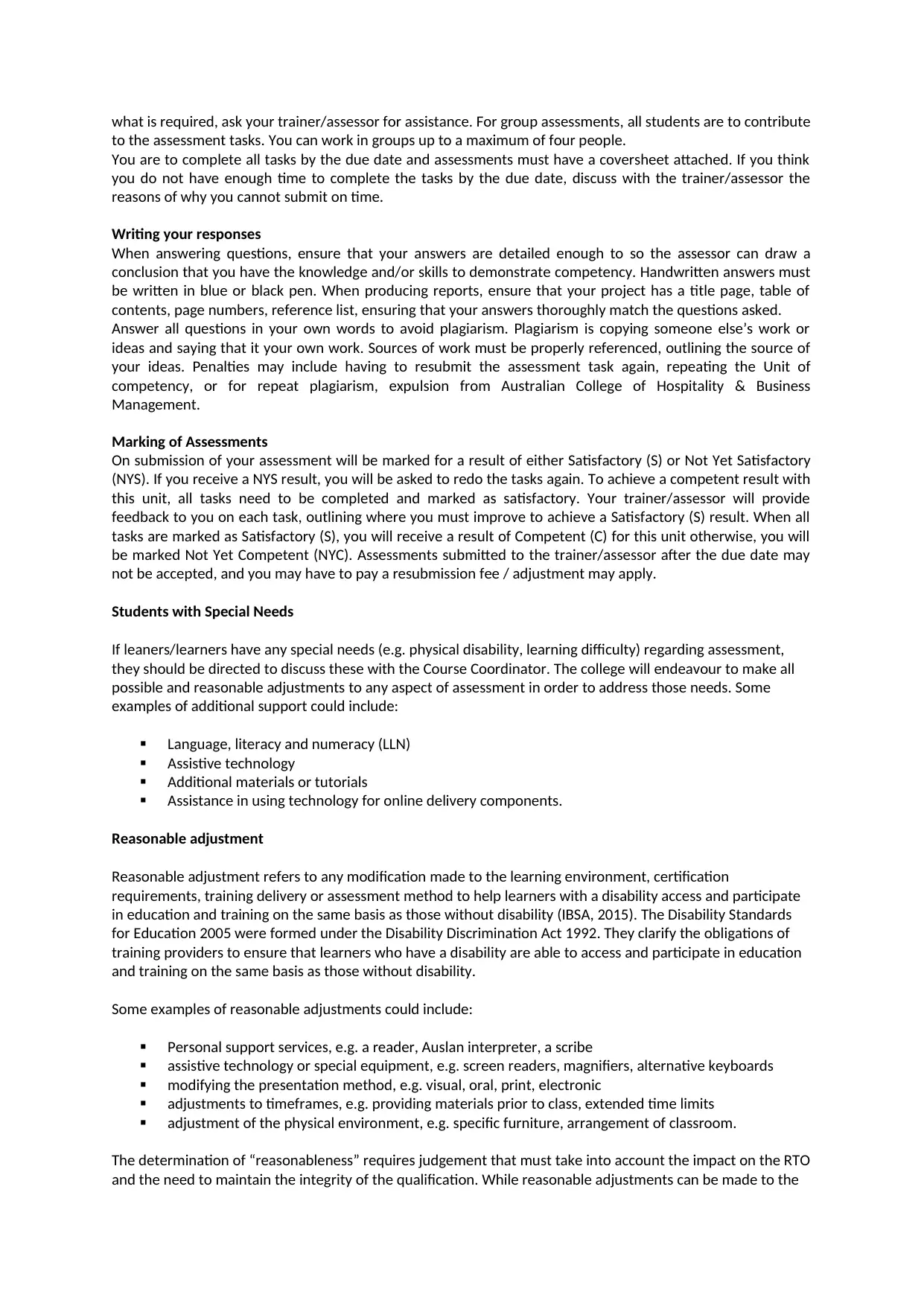
what is required, ask your trainer/assessor for assistance. For group assessments, all students are to contribute
to the assessment tasks. You can work in groups up to a maximum of four people.
You are to complete all tasks by the due date and assessments must have a coversheet attached. If you think
you do not have enough time to complete the tasks by the due date, discuss with the trainer/assessor the
reasons of why you cannot submit on time.
Writing your responses
When answering questions, ensure that your answers are detailed enough to so the assessor can draw a
conclusion that you have the knowledge and/or skills to demonstrate competency. Handwritten answers must
be written in blue or black pen. When producing reports, ensure that your project has a title page, table of
contents, page numbers, reference list, ensuring that your answers thoroughly match the questions asked.
Answer all questions in your own words to avoid plagiarism. Plagiarism is copying someone else’s work or
ideas and saying that it your own work. Sources of work must be properly referenced, outlining the source of
your ideas. Penalties may include having to resubmit the assessment task again, repeating the Unit of
competency, or for repeat plagiarism, expulsion from Australian College of Hospitality & Business
Management.
Marking of Assessments
On submission of your assessment will be marked for a result of either Satisfactory (S) or Not Yet Satisfactory
(NYS). If you receive a NYS result, you will be asked to redo the tasks again. To achieve a competent result with
this unit, all tasks need to be completed and marked as satisfactory. Your trainer/assessor will provide
feedback to you on each task, outlining where you must improve to achieve a Satisfactory (S) result. When all
tasks are marked as Satisfactory (S), you will receive a result of Competent (C) for this unit otherwise, you will
be marked Not Yet Competent (NYC). Assessments submitted to the trainer/assessor after the due date may
not be accepted, and you may have to pay a resubmission fee / adjustment may apply.
Students with Special Needs
If leaners/learners have any special needs (e.g. physical disability, learning difficulty) regarding assessment,
they should be directed to discuss these with the Course Coordinator. The college will endeavour to make all
possible and reasonable adjustments to any aspect of assessment in order to address those needs. Some
examples of additional support could include:
Language, literacy and numeracy (LLN)
Assistive technology
Additional materials or tutorials
Assistance in using technology for online delivery components.
Reasonable adjustment
Reasonable adjustment refers to any modification made to the learning environment, certification
requirements, training delivery or assessment method to help learners with a disability access and participate
in education and training on the same basis as those without disability (IBSA, 2015). The Disability Standards
for Education 2005 were formed under the Disability Discrimination Act 1992. They clarify the obligations of
training providers to ensure that learners who have a disability are able to access and participate in education
and training on the same basis as those without disability.
Some examples of reasonable adjustments could include:
Personal support services, e.g. a reader, Auslan interpreter, a scribe
assistive technology or special equipment, e.g. screen readers, magnifiers, alternative keyboards
modifying the presentation method, e.g. visual, oral, print, electronic
adjustments to timeframes, e.g. providing materials prior to class, extended time limits
adjustment of the physical environment, e.g. specific furniture, arrangement of classroom.
The determination of “reasonableness” requires judgement that must take into account the impact on the RTO
and the need to maintain the integrity of the qualification. While reasonable adjustments can be made to the
to the assessment tasks. You can work in groups up to a maximum of four people.
You are to complete all tasks by the due date and assessments must have a coversheet attached. If you think
you do not have enough time to complete the tasks by the due date, discuss with the trainer/assessor the
reasons of why you cannot submit on time.
Writing your responses
When answering questions, ensure that your answers are detailed enough to so the assessor can draw a
conclusion that you have the knowledge and/or skills to demonstrate competency. Handwritten answers must
be written in blue or black pen. When producing reports, ensure that your project has a title page, table of
contents, page numbers, reference list, ensuring that your answers thoroughly match the questions asked.
Answer all questions in your own words to avoid plagiarism. Plagiarism is copying someone else’s work or
ideas and saying that it your own work. Sources of work must be properly referenced, outlining the source of
your ideas. Penalties may include having to resubmit the assessment task again, repeating the Unit of
competency, or for repeat plagiarism, expulsion from Australian College of Hospitality & Business
Management.
Marking of Assessments
On submission of your assessment will be marked for a result of either Satisfactory (S) or Not Yet Satisfactory
(NYS). If you receive a NYS result, you will be asked to redo the tasks again. To achieve a competent result with
this unit, all tasks need to be completed and marked as satisfactory. Your trainer/assessor will provide
feedback to you on each task, outlining where you must improve to achieve a Satisfactory (S) result. When all
tasks are marked as Satisfactory (S), you will receive a result of Competent (C) for this unit otherwise, you will
be marked Not Yet Competent (NYC). Assessments submitted to the trainer/assessor after the due date may
not be accepted, and you may have to pay a resubmission fee / adjustment may apply.
Students with Special Needs
If leaners/learners have any special needs (e.g. physical disability, learning difficulty) regarding assessment,
they should be directed to discuss these with the Course Coordinator. The college will endeavour to make all
possible and reasonable adjustments to any aspect of assessment in order to address those needs. Some
examples of additional support could include:
Language, literacy and numeracy (LLN)
Assistive technology
Additional materials or tutorials
Assistance in using technology for online delivery components.
Reasonable adjustment
Reasonable adjustment refers to any modification made to the learning environment, certification
requirements, training delivery or assessment method to help learners with a disability access and participate
in education and training on the same basis as those without disability (IBSA, 2015). The Disability Standards
for Education 2005 were formed under the Disability Discrimination Act 1992. They clarify the obligations of
training providers to ensure that learners who have a disability are able to access and participate in education
and training on the same basis as those without disability.
Some examples of reasonable adjustments could include:
Personal support services, e.g. a reader, Auslan interpreter, a scribe
assistive technology or special equipment, e.g. screen readers, magnifiers, alternative keyboards
modifying the presentation method, e.g. visual, oral, print, electronic
adjustments to timeframes, e.g. providing materials prior to class, extended time limits
adjustment of the physical environment, e.g. specific furniture, arrangement of classroom.
The determination of “reasonableness” requires judgement that must take into account the impact on the RTO
and the need to maintain the integrity of the qualification. While reasonable adjustments can be made to the
⊘ This is a preview!⊘
Do you want full access?
Subscribe today to unlock all pages.

Trusted by 1+ million students worldwide
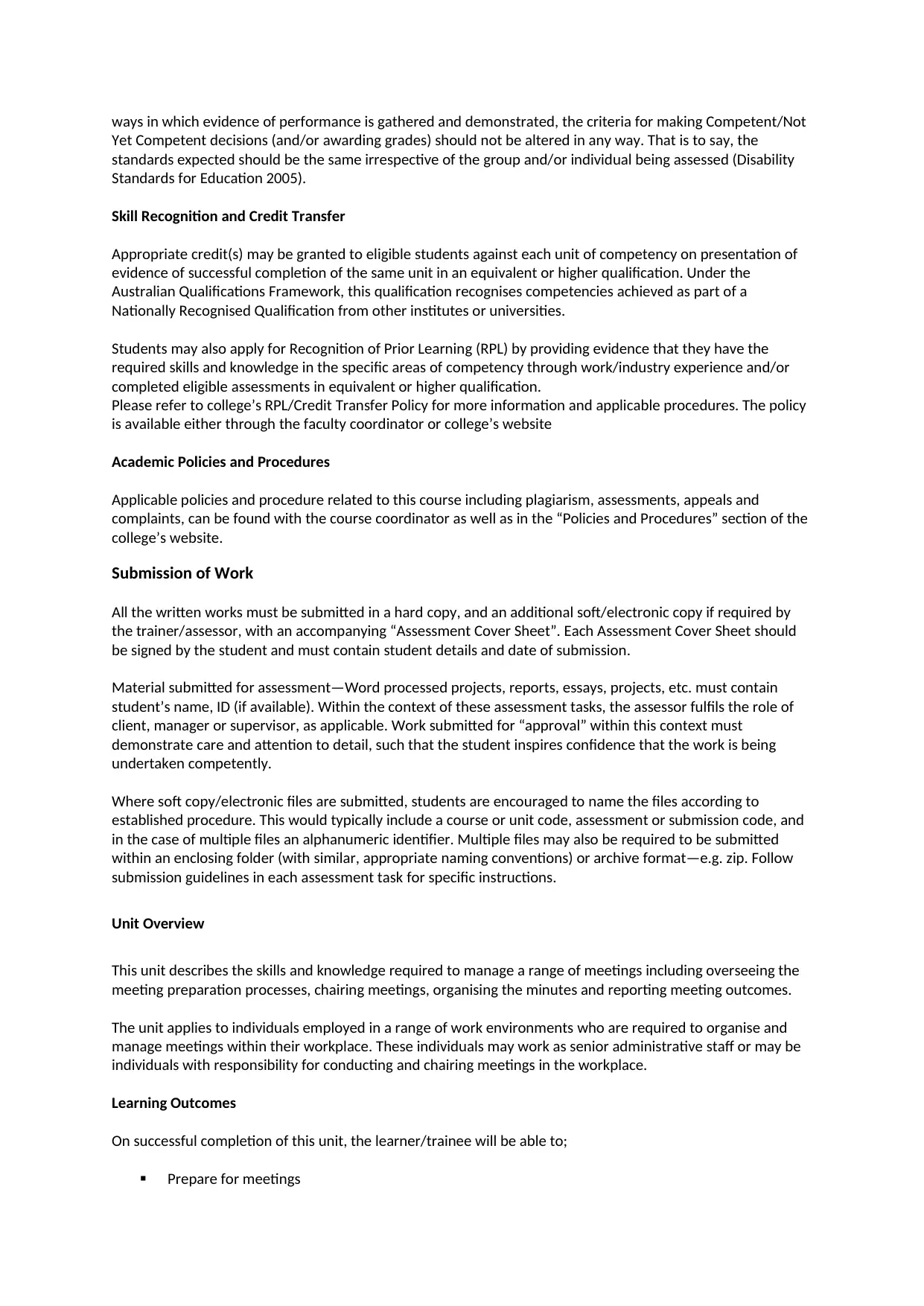
ways in which evidence of performance is gathered and demonstrated, the criteria for making Competent/Not
Yet Competent decisions (and/or awarding grades) should not be altered in any way. That is to say, the
standards expected should be the same irrespective of the group and/or individual being assessed (Disability
Standards for Education 2005).
Skill Recognition and Credit Transfer
Appropriate credit(s) may be granted to eligible students against each unit of competency on presentation of
evidence of successful completion of the same unit in an equivalent or higher qualification. Under the
Australian Qualifications Framework, this qualification recognises competencies achieved as part of a
Nationally Recognised Qualification from other institutes or universities.
Students may also apply for Recognition of Prior Learning (RPL) by providing evidence that they have the
required skills and knowledge in the specific areas of competency through work/industry experience and/or
completed eligible assessments in equivalent or higher qualification.
Please refer to college’s RPL/Credit Transfer Policy for more information and applicable procedures. The policy
is available either through the faculty coordinator or college’s website
Academic Policies and Procedures
Applicable policies and procedure related to this course including plagiarism, assessments, appeals and
complaints, can be found with the course coordinator as well as in the “Policies and Procedures” section of the
college’s website.
Submission of Work
All the written works must be submitted in a hard copy, and an additional soft/electronic copy if required by
the trainer/assessor, with an accompanying “Assessment Cover Sheet”. Each Assessment Cover Sheet should
be signed by the student and must contain student details and date of submission.
Material submitted for assessment—Word processed projects, reports, essays, projects, etc. must contain
student’s name, ID (if available). Within the context of these assessment tasks, the assessor fulfils the role of
client, manager or supervisor, as applicable. Work submitted for “approval” within this context must
demonstrate care and attention to detail, such that the student inspires confidence that the work is being
undertaken competently.
Where soft copy/electronic files are submitted, students are encouraged to name the files according to
established procedure. This would typically include a course or unit code, assessment or submission code, and
in the case of multiple files an alphanumeric identifier. Multiple files may also be required to be submitted
within an enclosing folder (with similar, appropriate naming conventions) or archive format—e.g. zip. Follow
submission guidelines in each assessment task for specific instructions.
Unit Overview
This unit describes the skills and knowledge required to manage a range of meetings including overseeing the
meeting preparation processes, chairing meetings, organising the minutes and reporting meeting outcomes.
The unit applies to individuals employed in a range of work environments who are required to organise and
manage meetings within their workplace. These individuals may work as senior administrative staff or may be
individuals with responsibility for conducting and chairing meetings in the workplace.
Learning Outcomes
On successful completion of this unit, the learner/trainee will be able to;
Prepare for meetings
Yet Competent decisions (and/or awarding grades) should not be altered in any way. That is to say, the
standards expected should be the same irrespective of the group and/or individual being assessed (Disability
Standards for Education 2005).
Skill Recognition and Credit Transfer
Appropriate credit(s) may be granted to eligible students against each unit of competency on presentation of
evidence of successful completion of the same unit in an equivalent or higher qualification. Under the
Australian Qualifications Framework, this qualification recognises competencies achieved as part of a
Nationally Recognised Qualification from other institutes or universities.
Students may also apply for Recognition of Prior Learning (RPL) by providing evidence that they have the
required skills and knowledge in the specific areas of competency through work/industry experience and/or
completed eligible assessments in equivalent or higher qualification.
Please refer to college’s RPL/Credit Transfer Policy for more information and applicable procedures. The policy
is available either through the faculty coordinator or college’s website
Academic Policies and Procedures
Applicable policies and procedure related to this course including plagiarism, assessments, appeals and
complaints, can be found with the course coordinator as well as in the “Policies and Procedures” section of the
college’s website.
Submission of Work
All the written works must be submitted in a hard copy, and an additional soft/electronic copy if required by
the trainer/assessor, with an accompanying “Assessment Cover Sheet”. Each Assessment Cover Sheet should
be signed by the student and must contain student details and date of submission.
Material submitted for assessment—Word processed projects, reports, essays, projects, etc. must contain
student’s name, ID (if available). Within the context of these assessment tasks, the assessor fulfils the role of
client, manager or supervisor, as applicable. Work submitted for “approval” within this context must
demonstrate care and attention to detail, such that the student inspires confidence that the work is being
undertaken competently.
Where soft copy/electronic files are submitted, students are encouraged to name the files according to
established procedure. This would typically include a course or unit code, assessment or submission code, and
in the case of multiple files an alphanumeric identifier. Multiple files may also be required to be submitted
within an enclosing folder (with similar, appropriate naming conventions) or archive format—e.g. zip. Follow
submission guidelines in each assessment task for specific instructions.
Unit Overview
This unit describes the skills and knowledge required to manage a range of meetings including overseeing the
meeting preparation processes, chairing meetings, organising the minutes and reporting meeting outcomes.
The unit applies to individuals employed in a range of work environments who are required to organise and
manage meetings within their workplace. These individuals may work as senior administrative staff or may be
individuals with responsibility for conducting and chairing meetings in the workplace.
Learning Outcomes
On successful completion of this unit, the learner/trainee will be able to;
Prepare for meetings
Paraphrase This Document
Need a fresh take? Get an instant paraphrase of this document with our AI Paraphraser
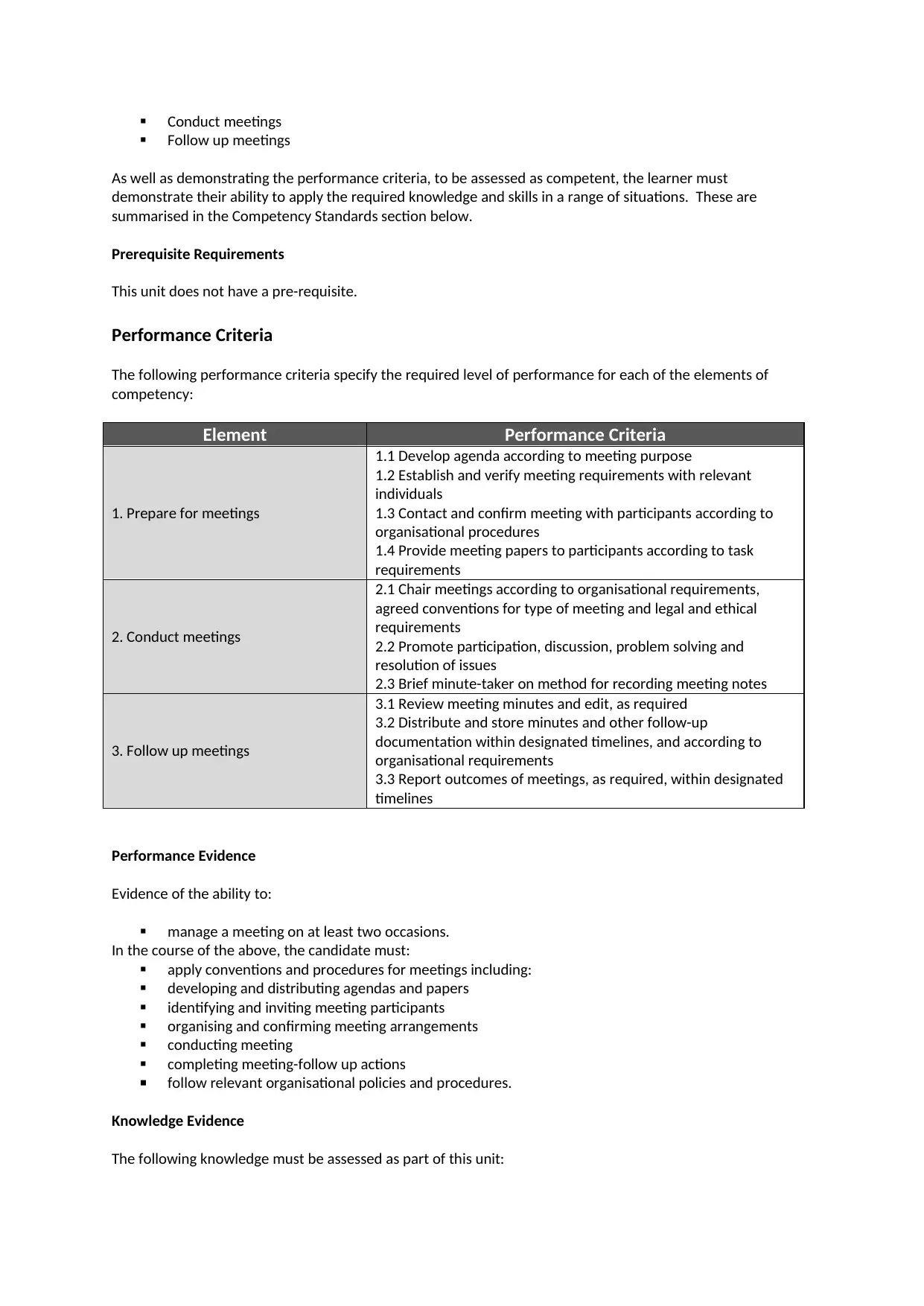
Conduct meetings
Follow up meetings
As well as demonstrating the performance criteria, to be assessed as competent, the learner must
demonstrate their ability to apply the required knowledge and skills in a range of situations. These are
summarised in the Competency Standards section below.
Prerequisite Requirements
This unit does not have a pre-requisite.
Performance Criteria
The following performance criteria specify the required level of performance for each of the elements of
competency:
Element Performance Criteria
1. Prepare for meetings
1.1 Develop agenda according to meeting purpose
1.2 Establish and verify meeting requirements with relevant
individuals
1.3 Contact and confirm meeting with participants according to
organisational procedures
1.4 Provide meeting papers to participants according to task
requirements
2. Conduct meetings
2.1 Chair meetings according to organisational requirements,
agreed conventions for type of meeting and legal and ethical
requirements
2.2 Promote participation, discussion, problem solving and
resolution of issues
2.3 Brief minute-taker on method for recording meeting notes
3. Follow up meetings
3.1 Review meeting minutes and edit, as required
3.2 Distribute and store minutes and other follow-up
documentation within designated timelines, and according to
organisational requirements
3.3 Report outcomes of meetings, as required, within designated
timelines
Performance Evidence
Evidence of the ability to:
manage a meeting on at least two occasions.
In the course of the above, the candidate must:
apply conventions and procedures for meetings including:
developing and distributing agendas and papers
identifying and inviting meeting participants
organising and confirming meeting arrangements
conducting meeting
completing meeting-follow up actions
follow relevant organisational policies and procedures.
Knowledge Evidence
The following knowledge must be assessed as part of this unit:
Follow up meetings
As well as demonstrating the performance criteria, to be assessed as competent, the learner must
demonstrate their ability to apply the required knowledge and skills in a range of situations. These are
summarised in the Competency Standards section below.
Prerequisite Requirements
This unit does not have a pre-requisite.
Performance Criteria
The following performance criteria specify the required level of performance for each of the elements of
competency:
Element Performance Criteria
1. Prepare for meetings
1.1 Develop agenda according to meeting purpose
1.2 Establish and verify meeting requirements with relevant
individuals
1.3 Contact and confirm meeting with participants according to
organisational procedures
1.4 Provide meeting papers to participants according to task
requirements
2. Conduct meetings
2.1 Chair meetings according to organisational requirements,
agreed conventions for type of meeting and legal and ethical
requirements
2.2 Promote participation, discussion, problem solving and
resolution of issues
2.3 Brief minute-taker on method for recording meeting notes
3. Follow up meetings
3.1 Review meeting minutes and edit, as required
3.2 Distribute and store minutes and other follow-up
documentation within designated timelines, and according to
organisational requirements
3.3 Report outcomes of meetings, as required, within designated
timelines
Performance Evidence
Evidence of the ability to:
manage a meeting on at least two occasions.
In the course of the above, the candidate must:
apply conventions and procedures for meetings including:
developing and distributing agendas and papers
identifying and inviting meeting participants
organising and confirming meeting arrangements
conducting meeting
completing meeting-follow up actions
follow relevant organisational policies and procedures.
Knowledge Evidence
The following knowledge must be assessed as part of this unit:
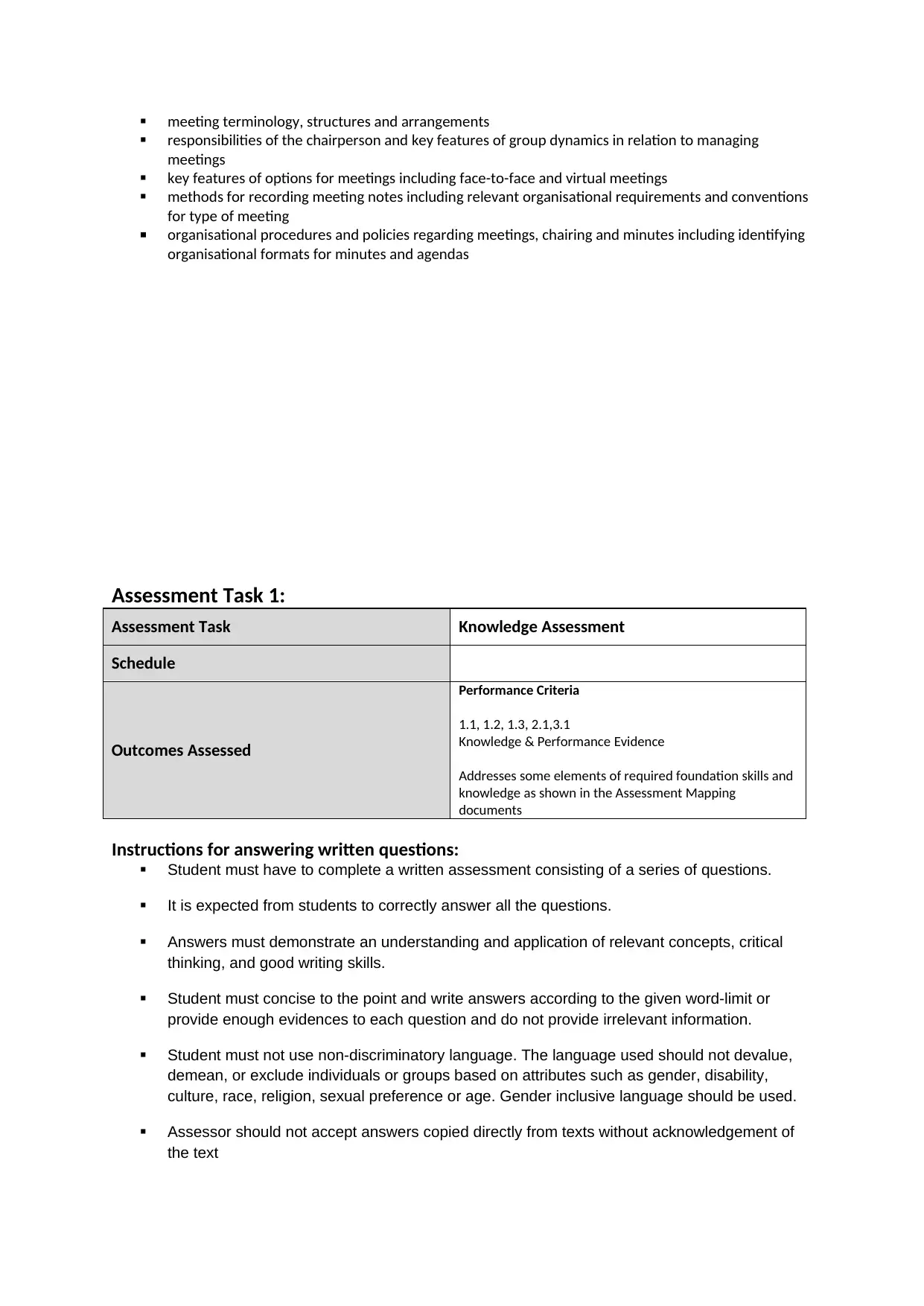
meeting terminology, structures and arrangements
responsibilities of the chairperson and key features of group dynamics in relation to managing
meetings
key features of options for meetings including face-to-face and virtual meetings
methods for recording meeting notes including relevant organisational requirements and conventions
for type of meeting
organisational procedures and policies regarding meetings, chairing and minutes including identifying
organisational formats for minutes and agendas
Assessment Task 1:
Assessment Task Knowledge Assessment
Schedule
Outcomes Assessed
Performance Criteria
1.1, 1.2, 1.3, 2.1,3.1
Knowledge & Performance Evidence
Addresses some elements of required foundation skills and
knowledge as shown in the Assessment Mapping
documents
Instructions for answering written questions:
Student must have to complete a written assessment consisting of a series of questions.
It is expected from students to correctly answer all the questions.
Answers must demonstrate an understanding and application of relevant concepts, critical
thinking, and good writing skills.
Student must concise to the point and write answers according to the given word-limit or
provide enough evidences to each question and do not provide irrelevant information.
Student must not use non-discriminatory language. The language used should not devalue,
demean, or exclude individuals or groups based on attributes such as gender, disability,
culture, race, religion, sexual preference or age. Gender inclusive language should be used.
Assessor should not accept answers copied directly from texts without acknowledgement of
the text
responsibilities of the chairperson and key features of group dynamics in relation to managing
meetings
key features of options for meetings including face-to-face and virtual meetings
methods for recording meeting notes including relevant organisational requirements and conventions
for type of meeting
organisational procedures and policies regarding meetings, chairing and minutes including identifying
organisational formats for minutes and agendas
Assessment Task 1:
Assessment Task Knowledge Assessment
Schedule
Outcomes Assessed
Performance Criteria
1.1, 1.2, 1.3, 2.1,3.1
Knowledge & Performance Evidence
Addresses some elements of required foundation skills and
knowledge as shown in the Assessment Mapping
documents
Instructions for answering written questions:
Student must have to complete a written assessment consisting of a series of questions.
It is expected from students to correctly answer all the questions.
Answers must demonstrate an understanding and application of relevant concepts, critical
thinking, and good writing skills.
Student must concise to the point and write answers according to the given word-limit or
provide enough evidences to each question and do not provide irrelevant information.
Student must not use non-discriminatory language. The language used should not devalue,
demean, or exclude individuals or groups based on attributes such as gender, disability,
culture, race, religion, sexual preference or age. Gender inclusive language should be used.
Assessor should not accept answers copied directly from texts without acknowledgement of
the text
⊘ This is a preview!⊘
Do you want full access?
Subscribe today to unlock all pages.

Trusted by 1+ million students worldwide
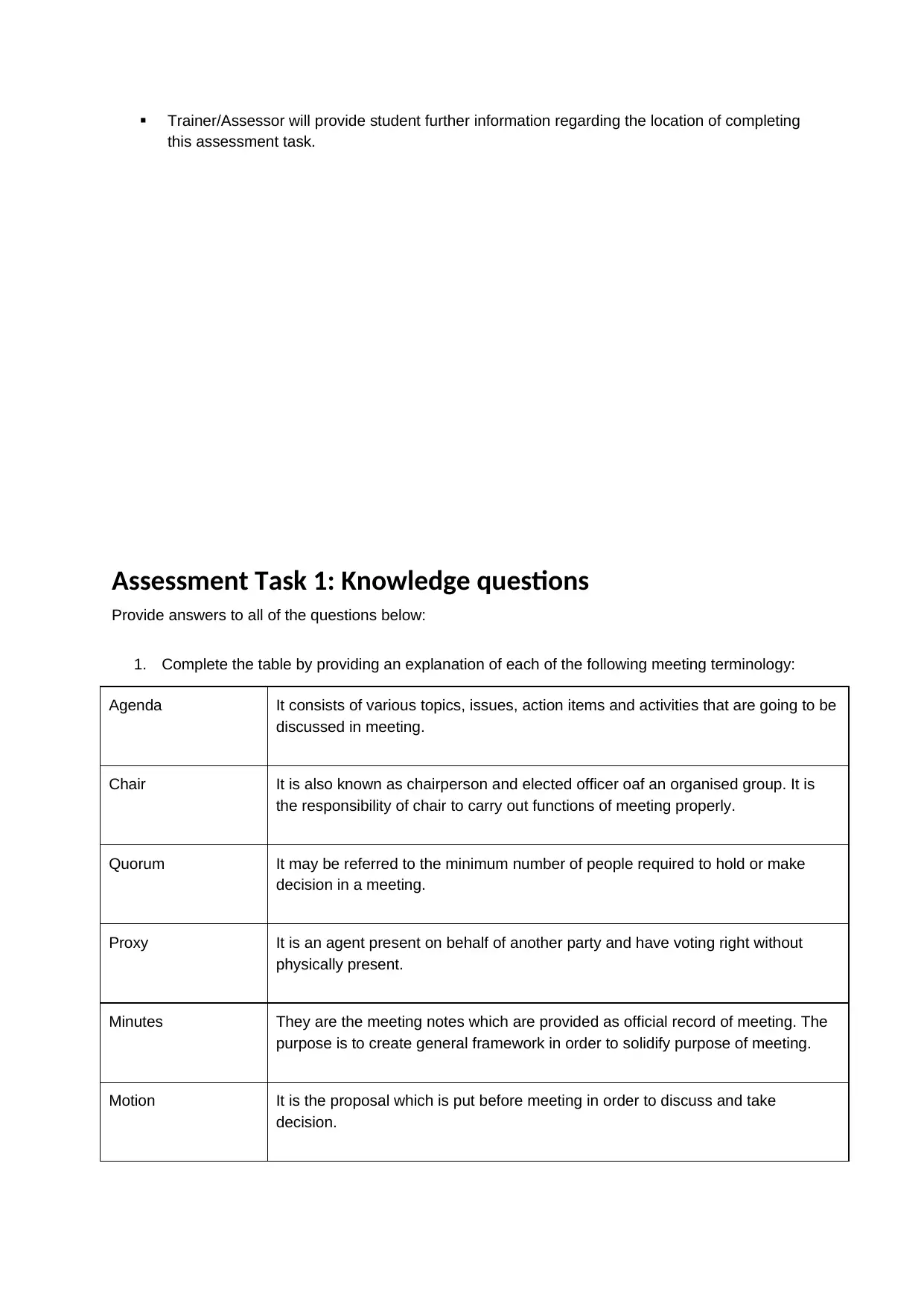
Trainer/Assessor will provide student further information regarding the location of completing
this assessment task.
Assessment Task 1: Knowledge questions
Provide answers to all of the questions below:
1. Complete the table by providing an explanation of each of the following meeting terminology:
Agenda It consists of various topics, issues, action items and activities that are going to be
discussed in meeting.
Chair It is also known as chairperson and elected officer oaf an organised group. It is
the responsibility of chair to carry out functions of meeting properly.
Quorum It may be referred to the minimum number of people required to hold or make
decision in a meeting.
Proxy It is an agent present on behalf of another party and have voting right without
physically present.
Minutes They are the meeting notes which are provided as official record of meeting. The
purpose is to create general framework in order to solidify purpose of meeting.
Motion It is the proposal which is put before meeting in order to discuss and take
decision.
this assessment task.
Assessment Task 1: Knowledge questions
Provide answers to all of the questions below:
1. Complete the table by providing an explanation of each of the following meeting terminology:
Agenda It consists of various topics, issues, action items and activities that are going to be
discussed in meeting.
Chair It is also known as chairperson and elected officer oaf an organised group. It is
the responsibility of chair to carry out functions of meeting properly.
Quorum It may be referred to the minimum number of people required to hold or make
decision in a meeting.
Proxy It is an agent present on behalf of another party and have voting right without
physically present.
Minutes They are the meeting notes which are provided as official record of meeting. The
purpose is to create general framework in order to solidify purpose of meeting.
Motion It is the proposal which is put before meeting in order to discuss and take
decision.
Paraphrase This Document
Need a fresh take? Get an instant paraphrase of this document with our AI Paraphraser
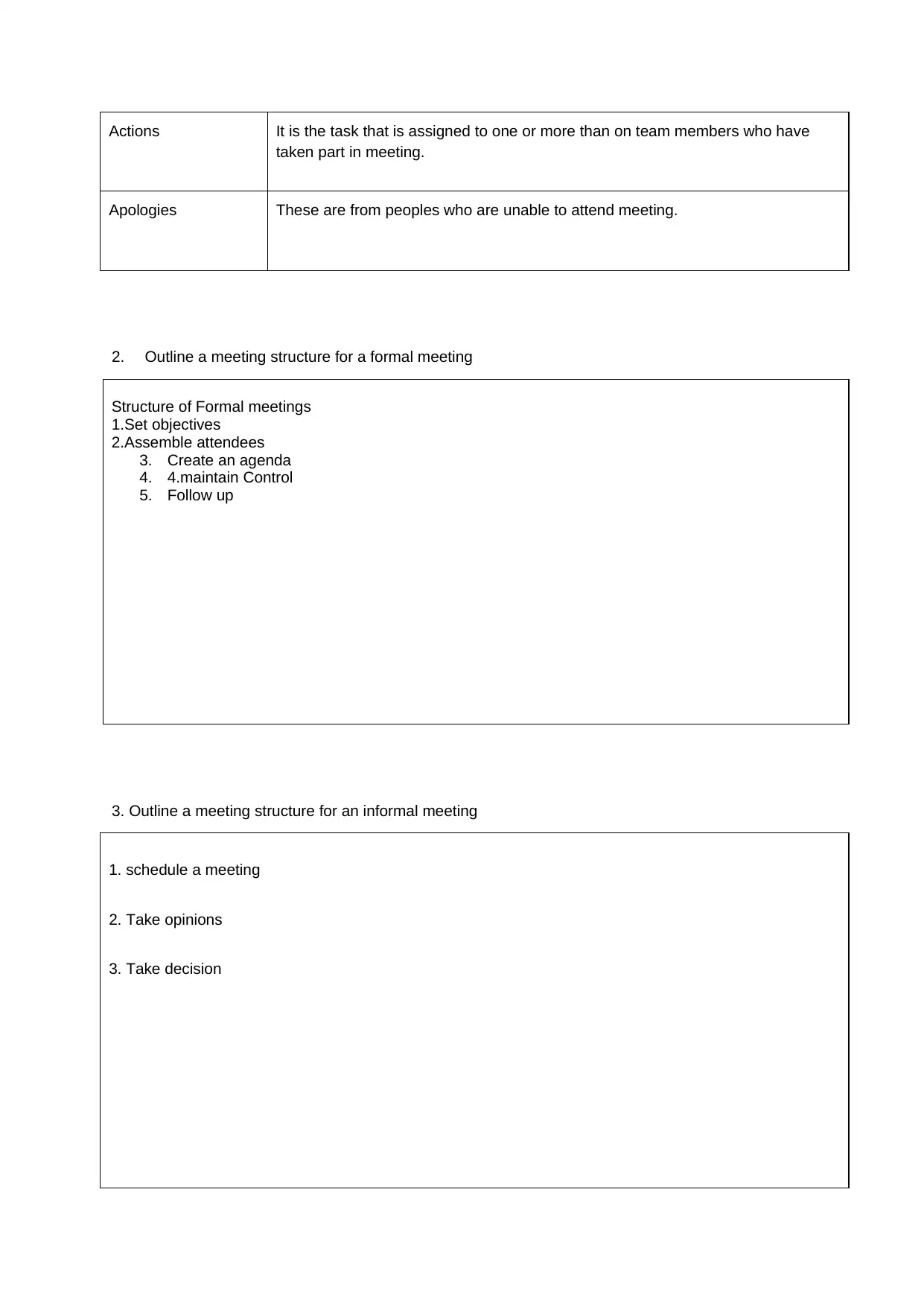
Actions It is the task that is assigned to one or more than on team members who have
taken part in meeting.
Apologies These are from peoples who are unable to attend meeting.
2. Outline a meeting structure for a formal meeting
Structure of Formal meetings
1.Set objectives
2.Assemble attendees
3. Create an agenda
4. 4.maintain Control
5. Follow up
3. Outline a meeting structure for an informal meeting
1. schedule a meeting
2. Take opinions
3. Take decision
taken part in meeting.
Apologies These are from peoples who are unable to attend meeting.
2. Outline a meeting structure for a formal meeting
Structure of Formal meetings
1.Set objectives
2.Assemble attendees
3. Create an agenda
4. 4.maintain Control
5. Follow up
3. Outline a meeting structure for an informal meeting
1. schedule a meeting
2. Take opinions
3. Take decision
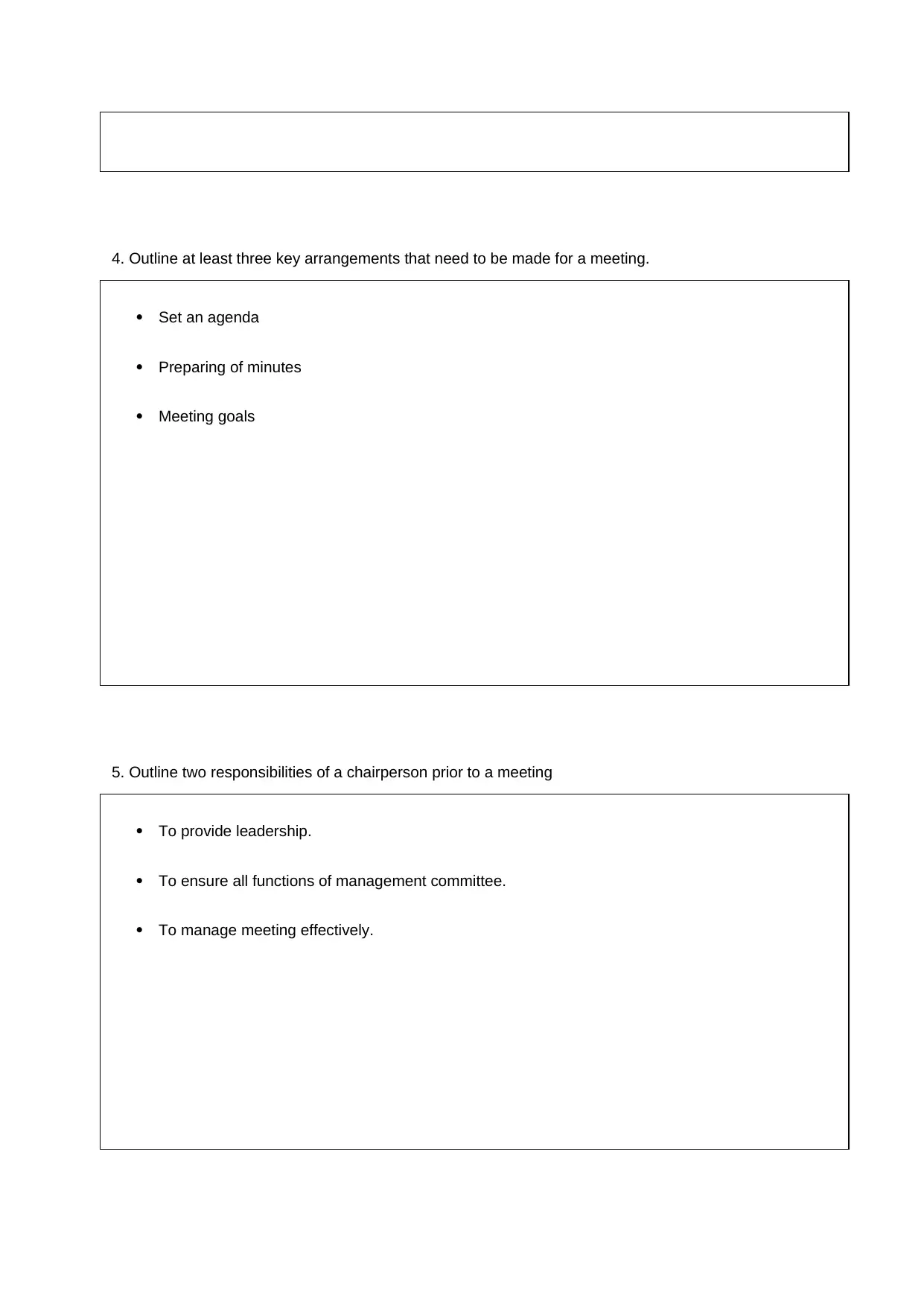
4. Outline at least three key arrangements that need to be made for a meeting.
Set an agenda
Preparing of minutes
Meeting goals
5. Outline two responsibilities of a chairperson prior to a meeting
To provide leadership.
To ensure all functions of management committee.
To manage meeting effectively.
Set an agenda
Preparing of minutes
Meeting goals
5. Outline two responsibilities of a chairperson prior to a meeting
To provide leadership.
To ensure all functions of management committee.
To manage meeting effectively.
⊘ This is a preview!⊘
Do you want full access?
Subscribe today to unlock all pages.

Trusted by 1+ million students worldwide
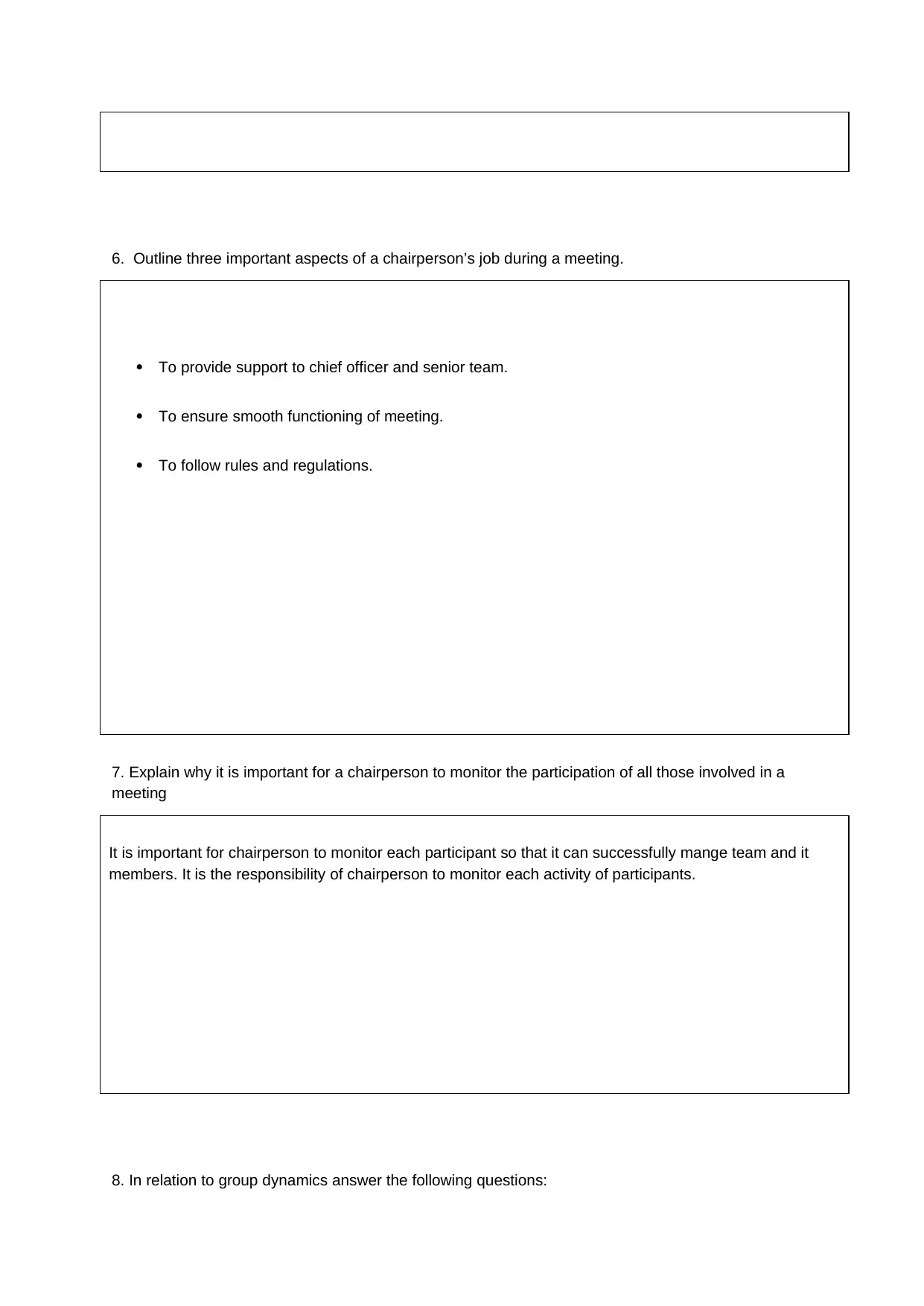
6. Outline three important aspects of a chairperson’s job during a meeting.
To provide support to chief officer and senior team.
To ensure smooth functioning of meeting.
To follow rules and regulations.
7. Explain why it is important for a chairperson to monitor the participation of all those involved in a
meeting
It is important for chairperson to monitor each participant so that it can successfully mange team and it
members. It is the responsibility of chairperson to monitor each activity of participants.
8. In relation to group dynamics answer the following questions:
To provide support to chief officer and senior team.
To ensure smooth functioning of meeting.
To follow rules and regulations.
7. Explain why it is important for a chairperson to monitor the participation of all those involved in a
meeting
It is important for chairperson to monitor each participant so that it can successfully mange team and it
members. It is the responsibility of chairperson to monitor each activity of participants.
8. In relation to group dynamics answer the following questions:
Paraphrase This Document
Need a fresh take? Get an instant paraphrase of this document with our AI Paraphraser
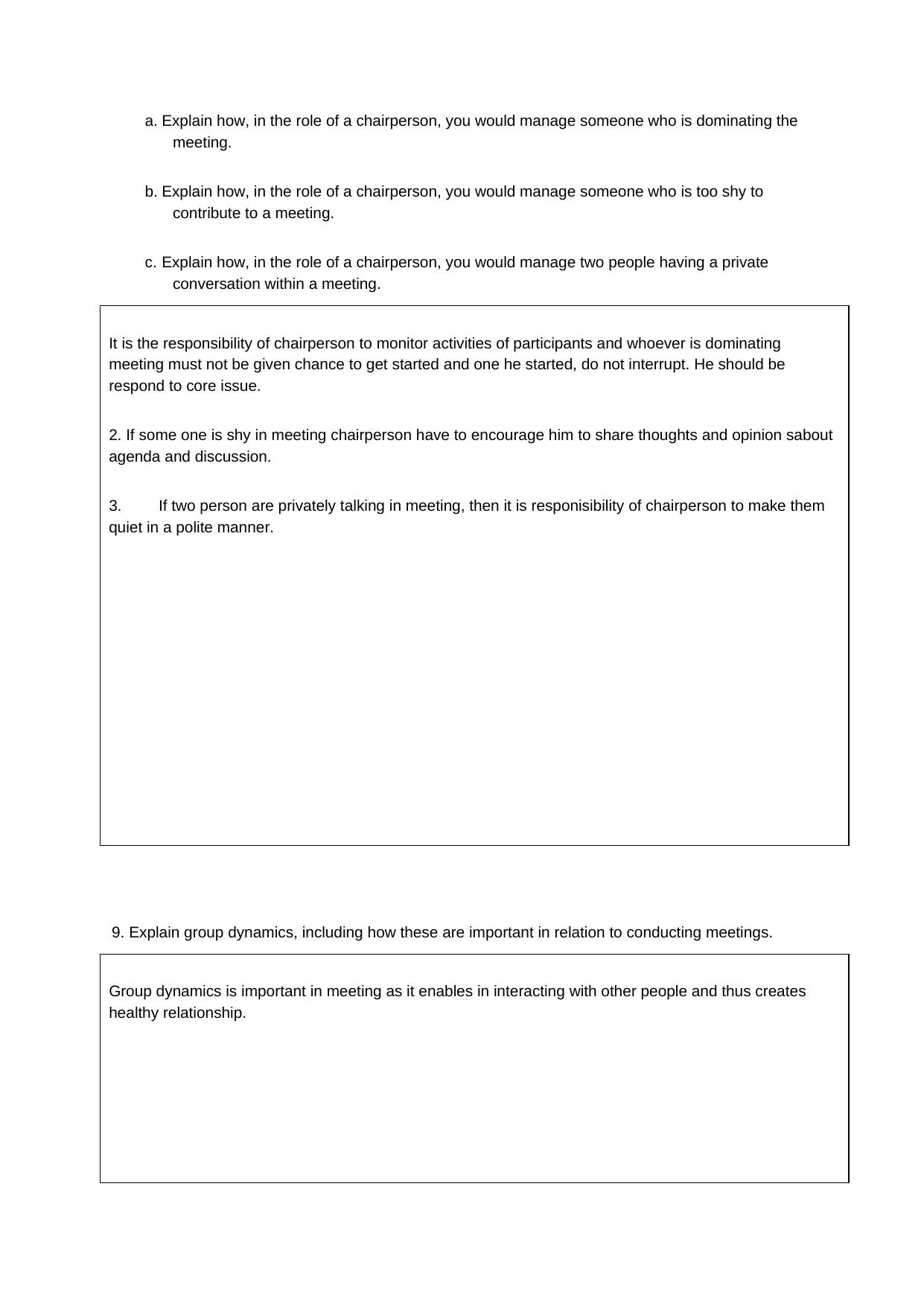
a. Explain how, in the role of a chairperson, you would manage someone who is dominating the
meeting.
b. Explain how, in the role of a chairperson, you would manage someone who is too shy to
contribute to a meeting.
c. Explain how, in the role of a chairperson, you would manage two people having a private
conversation within a meeting.
It is the responsibility of chairperson to monitor activities of participants and whoever is dominating
meeting must not be given chance to get started and one he started, do not interrupt. He should be
respond to core issue.
2. If some one is shy in meeting chairperson have to encourage him to share thoughts and opinion sabout
agenda and discussion.
3. If two person are privately talking in meeting, then it is responisibility of chairperson to make them
quiet in a polite manner.
9. Explain group dynamics, including how these are important in relation to conducting meetings.
Group dynamics is important in meeting as it enables in interacting with other people and thus creates
healthy relationship.
meeting.
b. Explain how, in the role of a chairperson, you would manage someone who is too shy to
contribute to a meeting.
c. Explain how, in the role of a chairperson, you would manage two people having a private
conversation within a meeting.
It is the responsibility of chairperson to monitor activities of participants and whoever is dominating
meeting must not be given chance to get started and one he started, do not interrupt. He should be
respond to core issue.
2. If some one is shy in meeting chairperson have to encourage him to share thoughts and opinion sabout
agenda and discussion.
3. If two person are privately talking in meeting, then it is responisibility of chairperson to make them
quiet in a polite manner.
9. Explain group dynamics, including how these are important in relation to conducting meetings.
Group dynamics is important in meeting as it enables in interacting with other people and thus creates
healthy relationship.
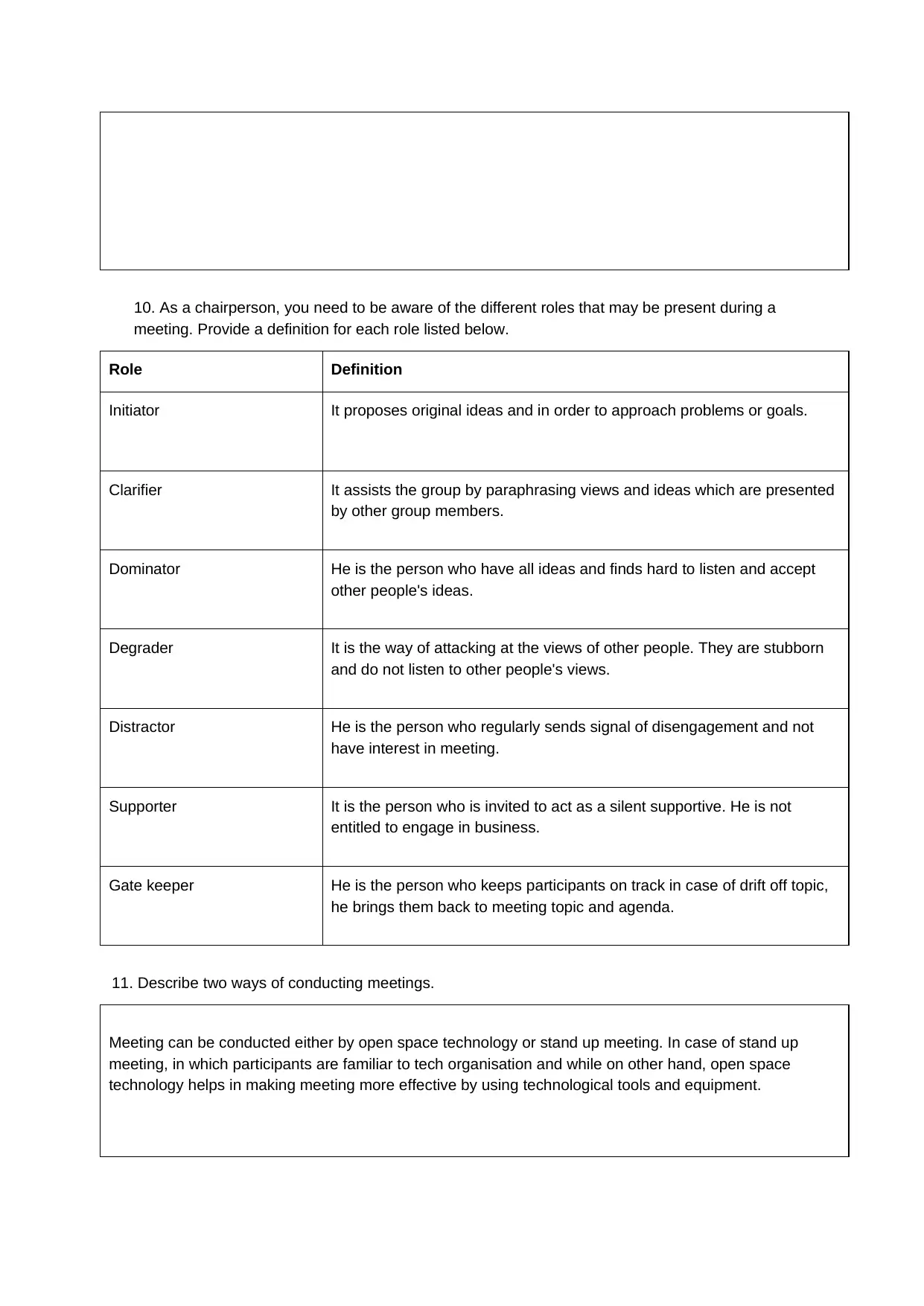
10. As a chairperson, you need to be aware of the different roles that may be present during a
meeting. Provide a definition for each role listed below.
Role Definition
Initiator It proposes original ideas and in order to approach problems or goals.
Clarifier It assists the group by paraphrasing views and ideas which are presented
by other group members.
Dominator He is the person who have all ideas and finds hard to listen and accept
other people's ideas.
Degrader It is the way of attacking at the views of other people. They are stubborn
and do not listen to other people's views.
Distractor He is the person who regularly sends signal of disengagement and not
have interest in meeting.
Supporter It is the person who is invited to act as a silent supportive. He is not
entitled to engage in business.
Gate keeper He is the person who keeps participants on track in case of drift off topic,
he brings them back to meeting topic and agenda.
11. Describe two ways of conducting meetings.
Meeting can be conducted either by open space technology or stand up meeting. In case of stand up
meeting, in which participants are familiar to tech organisation and while on other hand, open space
technology helps in making meeting more effective by using technological tools and equipment.
meeting. Provide a definition for each role listed below.
Role Definition
Initiator It proposes original ideas and in order to approach problems or goals.
Clarifier It assists the group by paraphrasing views and ideas which are presented
by other group members.
Dominator He is the person who have all ideas and finds hard to listen and accept
other people's ideas.
Degrader It is the way of attacking at the views of other people. They are stubborn
and do not listen to other people's views.
Distractor He is the person who regularly sends signal of disengagement and not
have interest in meeting.
Supporter It is the person who is invited to act as a silent supportive. He is not
entitled to engage in business.
Gate keeper He is the person who keeps participants on track in case of drift off topic,
he brings them back to meeting topic and agenda.
11. Describe two ways of conducting meetings.
Meeting can be conducted either by open space technology or stand up meeting. In case of stand up
meeting, in which participants are familiar to tech organisation and while on other hand, open space
technology helps in making meeting more effective by using technological tools and equipment.
⊘ This is a preview!⊘
Do you want full access?
Subscribe today to unlock all pages.

Trusted by 1+ million students worldwide
1 out of 22
Related Documents
Your All-in-One AI-Powered Toolkit for Academic Success.
+13062052269
info@desklib.com
Available 24*7 on WhatsApp / Email
![[object Object]](/_next/static/media/star-bottom.7253800d.svg)
Unlock your academic potential
Copyright © 2020–2025 A2Z Services. All Rights Reserved. Developed and managed by ZUCOL.




